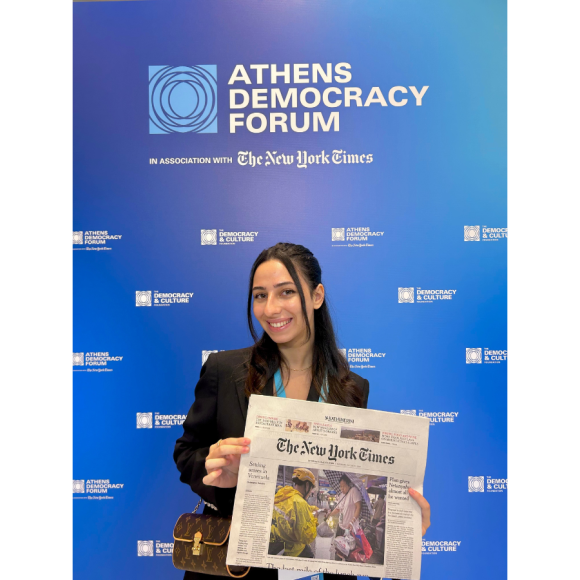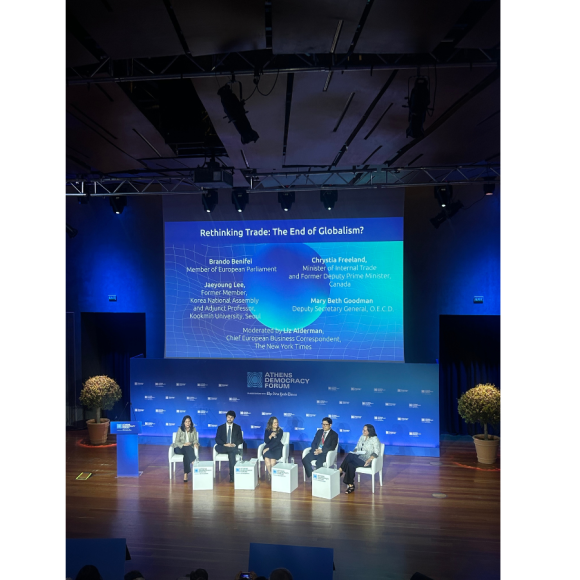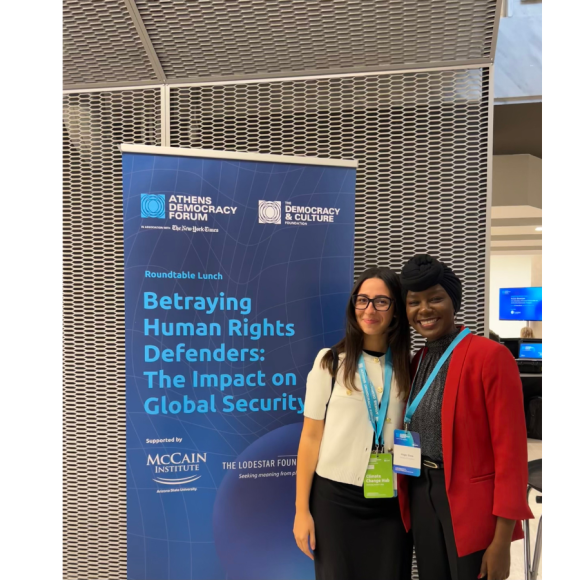Biology senior Laila Khalifa represented AUC and Egypt at the Athens Democracy Forum, an international conference where the brightest minds in politics, business, academia and civil society discuss global issues in modern democracy. She was the only representative from AUC among a cohort of international student delegates.
Organized by the Democracy and Culture Foundation in association with The New York Times, the Athens Democracy Forum was founded to innovate new ways of addressing global challenges to democracy. The forum invites dignitaries and thought leaders, including former presidents, European members of parliament and influential members of civil society. Participants networked together, engaging in constructive dialogue on democracy, the ethics of AI, climate change and more.
“The discussions were particularly stimulating because each group comprised participants from diverse cultural and national backgrounds," said Khalifa, who was nominated by AUC's Core Curriculum program. "It encouraged a rich exchange of perspectives and helped us reflect on how democratic values manifest differently across societies.”
“It was an honor to carry AUC’s name in such a prestigious global setting.”
The forum is co-organized by the Global Liberal Arts Alliance, of which AUC is a member. "The Athens Democracy Forum is one of various experiential learning opportunities organized by AUC's Core Curriculum program to extend liberal arts learning beyond courses and classrooms, and practice deep critical engagement with the issues that plague our world in authentic settings," said Ghada Elshimi, dean of undergraduate students and the Academy of Liberal Arts as well as director of the Core Curriculum. "Selection of students is a highly competitive process, both within AUC and among partnering universities."
In a roundtable covering research by two German students, Khalifa took part in discussions on how to engage younger audiences in democracy using AI and social media. She also had the opportunity to meet pioneers in the field, including Nobel laureate Maria Ressa, who spoke at the forum. Ressa was awarded the Nobel Peace Prize in 2021 “for [her] efforts to safeguard freedom of expression, which is a precondition for democracy and lasting peace.”
“It was an honor to carry AUC’s name in such a prestigious global setting.”
For Khalifa, the experience was transformative. “Throughout the forum, I had the privilege of meeting and engaging in conversations with an extraordinary range of individuals, including former presidents, policymakers, politicians, NGO leaders and professors from Ivy League universities, such as Yale and Stanford,” said Khalifa.
Though at first skeptical about how her major in biology and minors in business administration and chemistry would fit into the conference, Khalifa credits AUC’s liberal arts education with giving her the tools to engage with a high-level multidisciplinary forum. For example, Khalifa explored Plato’s views on democracy through AUC's Core Curriculum class on Philosophical Thinking, which she says, “laid the foundation for my understanding of many of the debates that took place.”
Working with international students as a resident adviser in the University’s Office of Residential Life also gave her a competitive edge when communicating across cultures. In addition, she was an active participant in the 2024 Times Higher Education Digital Universities Arab World Conference and the 2025 Student Leaders Global Summit (SLGS) in Cork, Ireland.
“I had the privilege of meeting and engaging in conversations with an extraordinary range of individuals, including former presidents, policymakers, politicians, NGO leaders and professors from Ivy League universities.”
“My interdisciplinary academic background, combined with my experience as a student leader and resident adviser, has contributed to shaping my perspective at the intersection of science, leadership and societal development. This has allowed me to bring a multidisciplinary perspective to the Athens Democracy Forum.”
Participating students start preparing for the forum during the summer, through cross-cultural workgroups to work on activities that familiarize them with the themes of the event. Students take part in decision making and policy discussions, and collaborate with peers from around the world.
In the summer leading up to the forum, Khalifa met biweekly with other student delegates from Oberlin College, the American College of Greece, the Universidad San Francisco de Quito and more to discuss the forum's key topics. A video Khalifa created as a final assignment of the summer program was selected to open a panel on planetary environmental governance at the Athens Democracy Forum. She called the opportunity to have her video viewed by panelists who included a Yale professor and London’s deputy mayor for environment and energy “an absolute highlight.” She also got the chance to explore Greece’s historic sites, including the Acropolis, the Acropolis Museum, and the Pnyx.
“My interdisciplinary academic background, combined with my experience as a student leader and resident adviser, has contributed to shaping my perspective at the intersection of science, leadership and societal development.”
Khalifa plans to bring the experience back to AUC, sharing her knowledge with classes and starting new initiatives through student organizations.
“As a student leader, I am very much eager to implement what I have learned by starting initiatives that promote civic engagement and sustainability with the guidance of my inspiring professors and mentors. I also hope to expand this impact beyond AUC by working with peers I met during the ADF to bring similar initiatives around the world.”
AUC biology senior Laila Khalifa represented AUC and Egypt on the world stage alongside former presidents, Nobel laureates, parliamentarians and business leaders















